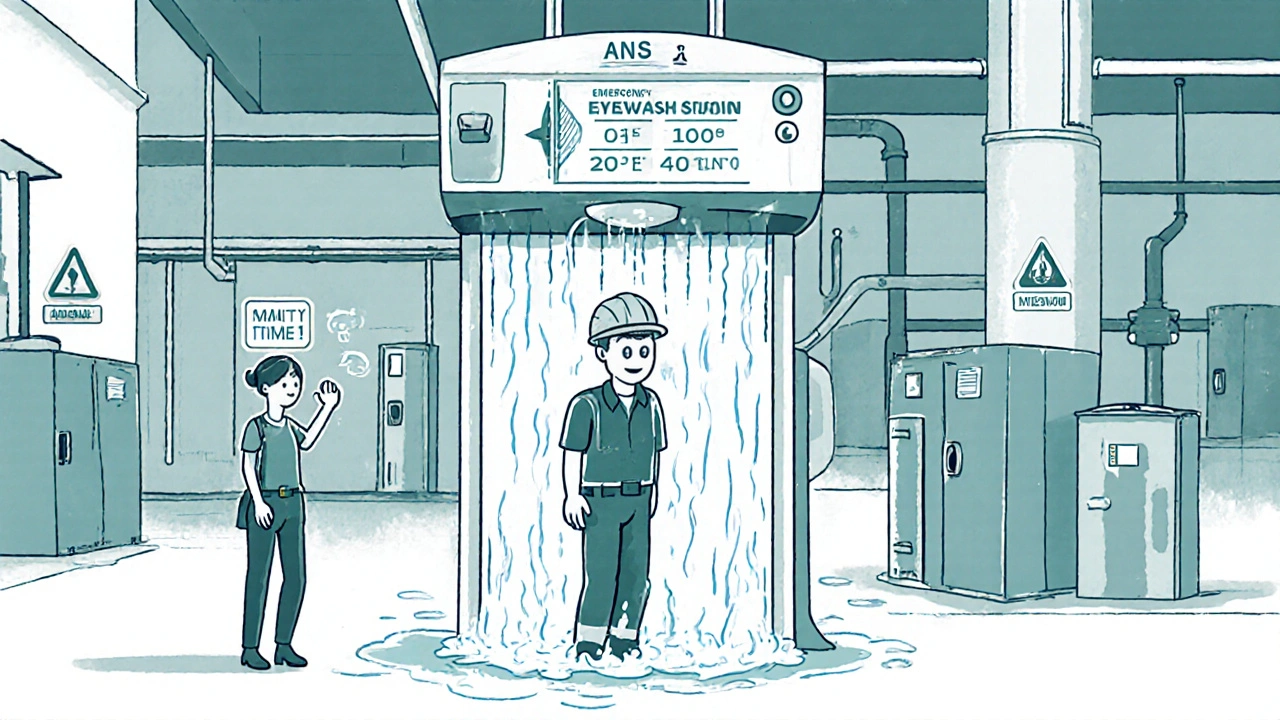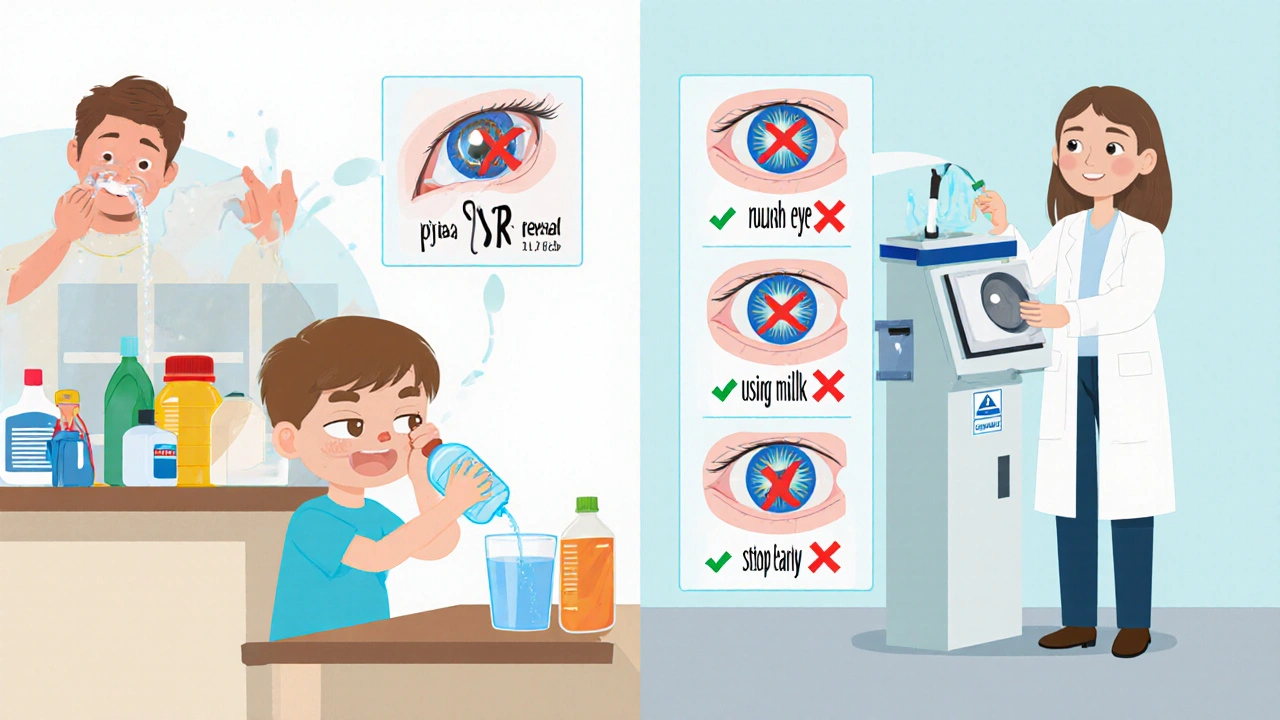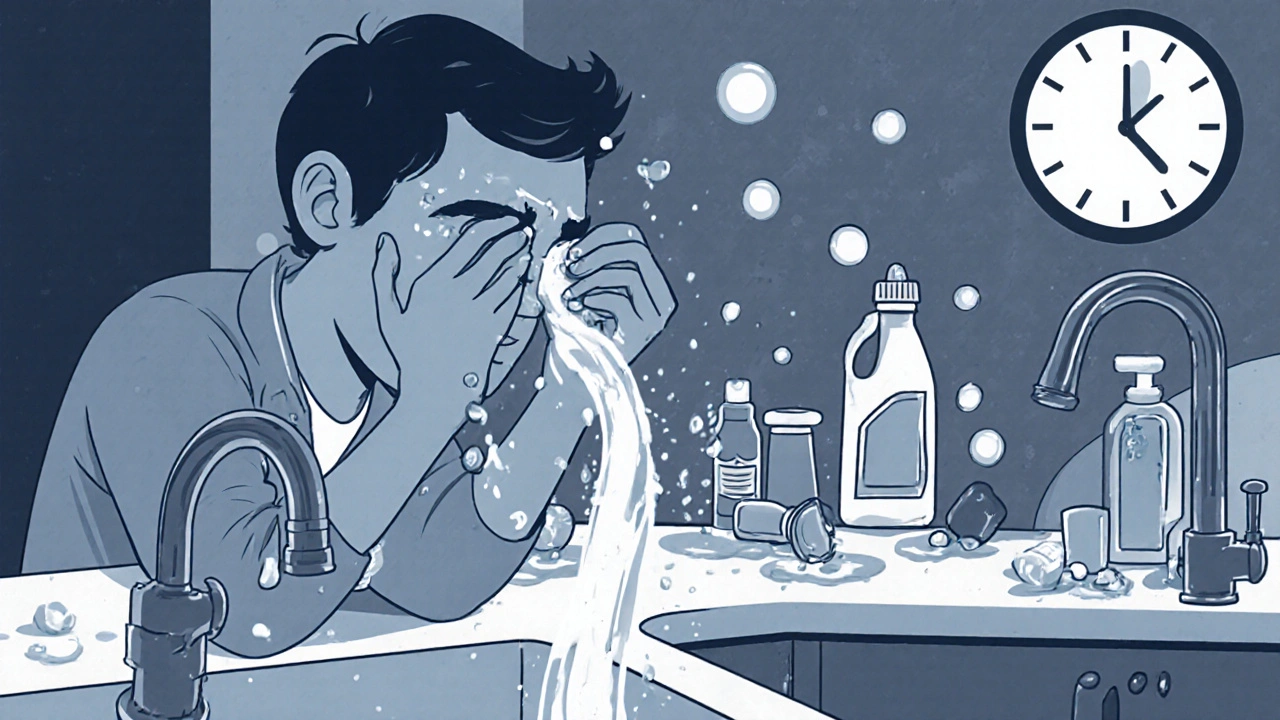One second. That’s all it takes for a chemical splash to turn a routine task into a medical emergency. Whether it’s cleaning product, battery acid, or even household ammonia, a splash to the eye can burn through tissue faster than you can blink. And if you don’t act fast, you could lose vision-permanently.
Why Speed Matters More Than Anything Else
Chemical eye injuries don’t wait. Alkali substances like drain cleaners or cement dust can penetrate deep into the eye within seconds, destroying the cornea and damaging the optic nerve. Acids, like those in toilet bowl cleaners, cause surface burns but are often less destructive because they coagulate tissue and form a barrier. Still, neither should be ignored.
Research shows that if you start flushing your eye within 10 seconds of exposure, your chance of avoiding permanent vision loss jumps by 76%. That’s not a guess-it’s from a 2017 meta-analysis in the British Journal of Ophthalmology. Every second counts. Delaying irrigation by even two minutes can double the risk of corneal perforation, according to the American Academy of Ophthalmology.
Most people don’t realize this: the goal isn’t to “clean” the eye. It’s to flood it. You need enough water to wash out every trace of the chemical. A quick rinse won’t cut it. You need continuous, high-volume irrigation.
The Exact Steps to Follow
Here’s what to do-step by step-right after a chemical splash:
- Don’t rub your eye. Rubbing spreads the chemical and digs it deeper into the tissue. This is the most common mistake-68.2% of victims do it, according to the American Red Cross.
- Get to water immediately. Don’t waste time looking for saline or special solutions. Tap water works just as well, and studies confirm it. Dr. Reay Brown from Bascom Palmer Eye Institute found no advantage to saline over plain water in initial treatment.
- Hold your eye open. Use your fingers to gently pull your upper and lower eyelids apart. You need the water to reach under both lids. If you can’t do it yourself, ask someone to help.
- Flush for at least 20 minutes. Healthdirect Australia, the Better Health Channel, and ANSI standards all agree: 15 to 20 minutes is the minimum. Don’t stop when it stops hurting. Chemicals can still be lingering. The CDC recommends checking the eye’s pH with litmus paper until it reaches 7.0-7.4. That might take longer than 20 minutes for strong alkalis.
- Position your head correctly. Tilt your head back and turn it toward the injured side. This keeps the chemical from flowing into your other eye. Only Healthdirect Australia specifically mentions this, but it’s critical. You don’t want to blind both eyes.
- Remove contact lenses only if possible. If you wear contacts, try to take them out while flushing-but only if it doesn’t cause more pain or damage. If the eye is too swollen or irritated, leave them in and let the water flush them out naturally. The CDC doesn’t address this, but Healthdirect Australia’s guidance is clear: remove if safe, otherwise don’t risk further injury.
- Keep flushing until help arrives. The American Red Cross says to keep going until EMS gets there. That’s the safest rule. Don’t assume 20 minutes is enough if you’re still in pain or your vision is blurry.
What Not to Do
It’s easy to panic and make things worse. Here are the top mistakes people make-and why they’re dangerous:
- Using a small cup of water. You need a steady stream. A cup holds maybe 8 ounces. You need at least 2 liters. That’s why emergency eyewash stations are designed to deliver 0.4 gallons per minute-enough to flood the eye without stopping.
- Applying pressure. Don’t press on the eyeball. That can rupture the cornea, especially if it’s already weakened by the chemical.
- Waiting to see if it gets better. Chemical burns don’t heal on their own. Even if your eye feels fine after a few minutes, damage can continue internally. You still need professional care.
- Using home remedies. No vinegar, no baking soda, no milk. These can react with chemicals and make things worse. Water is the only safe option for initial treatment.
- Stopping too soon. A 2022 study found that 57.3% of people stopped irrigation before completing the full time. They thought it was “good enough.” It wasn’t.

Workplace vs. Home: What’s Different?
If you’re at work, your employer is legally required to have an ANSI Z358.1-2021 compliant eyewash station nearby. That means:
- It must activate in under 1 second.
- It delivers tepid water (60-100°F) at 0.4 gallons per minute.
- It must be reachable within 10 seconds of the hazard.
But 22.8% of workplaces with chemical hazards still don’t meet this standard, according to OSHA’s 2023 audits. If you’re working with chemicals, know where the eyewash is. Test it monthly. If it’s broken, report it. Don’t wait for an accident to happen.
At home, you don’t have a fancy station. That’s why you need to prepare:
- Keep a bottle of sterile saline in your first aid kit-but remember, tap water works just as well.
- Store a clean, empty water bottle next to cleaning supplies. If a splash happens, you can quickly pour water from it into your eye.
- Teach everyone in your household what to do. A CDC survey found that 78.4% of households have no emergency eyewash solution ready. Only 12.3% know how long to flush.
What Happens After You Flush?
Even if you do everything right, you still need to see a doctor. Emergency flushing saves your vision, but it doesn’t fix the damage already done. You might have:
- Corneal abrasions
- Scarring or clouding of the cornea
- Increased eye pressure
- Long-term dry eye
Some patients need corneal transplants. According to 2023 Medicare data, those procedures cost an average of $27,700. Prevention is far cheaper.
Doctors may use special solutions like Diphoterine, an FDA-approved decontamination agent approved in 2022 that binds to chemicals instead of just diluting them. But you won’t have that at home. Your job is to flush, and flush well.

Training Makes a Difference
People who’ve had hands-on first aid training are 3.2 times more likely to do the right thing during an eye emergency, according to American Red Cross data. Reading a pamphlet won’t cut it. You need to practice.
Workplaces that run regular chemical safety drills see 30% fewer injuries. Schools, labs, and factories that include eye irrigation in their training see better compliance. If your job involves chemicals, ask for a live demo. If you’re a parent, teach your teens how to handle cleaning products safely.
The bottom line? You don’t need fancy equipment. You don’t need to be a doctor. You just need to act fast, flush long, and never stop until help arrives.
What to Keep in Your First Aid Kit
Here’s a simple checklist for home or car:
- One unopened bottle of sterile saline (for convenience, not necessity)
- Two clean, empty plastic water bottles (with caps removed)
- A small bottle of distilled water (in case tap water is unsafe)
- A pair of clean tweezers (for removing contact lenses if safe)
- A printed copy of the 20-minute flush instructions (keep it near cleaning supplies)
That’s it. No expensive gadgets. No special training required. Just awareness and preparation.
Can I use saline instead of water for a chemical eye splash?
Yes, you can use sterile saline if it’s immediately available. But don’t delay flushing to find it. Tap water works just as well-and studies show no benefit to saline in the first minutes after exposure. The key is speed and volume, not the type of liquid.
What if I can’t open my eye because it’s too painful?
Ask someone to help you hold your eyelids open. If no one is around, try using your fingers gently to pull the lids apart while you tilt your head under a running faucet. Even if it hurts, keep flushing. Pain doesn’t mean you’re making it worse-it means the chemical is still there.
Do I need to remove my contact lenses right away?
Only if you can do it without causing more pain or damage. If your eye is swollen or the lens is stuck, leave it in. The water will flush it out over time. Trying to force it out can scratch your cornea. The goal is to dilute the chemical-not add another injury.
Is it safe to use a shower for eye irrigation?
Yes, if you can’t reach a sink. Stand under a gentle stream of lukewarm water and tilt your head so the water flows across your eye. Keep your eye open. Don’t let the water hit directly on the eyeball-let it flow gently over it. A shower can work in an emergency, but a sink or eyewash station is better because you can control the flow.
How do I know if I need to go to the ER after flushing?
Go to the ER if you still have pain, blurred vision, redness, sensitivity to light, or the feeling that something is stuck in your eye-even after flushing for 20 minutes. Don’t wait. Some damage isn’t visible right away. A doctor needs to check for corneal ulcers, pressure changes, or hidden chemical residue.
Can children get chemical eye injuries from household cleaners?
Yes. In fact, children under 5 account for nearly 30% of non-workplace chemical eye injuries. Keep all cleaners locked up and out of reach. If a child gets splashed, flush immediately for 20 minutes and call emergency services. Never assume it’s “just a little splash.” Their eyes are more vulnerable.


Ryan Airey
November 14, 2025 AT 12:15Let’s be real-most people won’t flush for 20 minutes. They’ll do 30 seconds, say a prayer, and call 911. That’s why so many end up with permanent damage. This isn’t just first aid-it’s a survival skill, and we treat it like a trivia question. We need mandatory eye-flush drills in schools, just like fire drills. No more ‘maybe I’ll learn it later.’
BABA SABKA
November 15, 2025 AT 06:11Bro, the CDC and ANSI are just corporate mouthpieces. They push tap water because it’s cheap. Real professionals use Diphoterine-it’s pH-neutral, binds toxins, and doesn’t dilute the chemical into deeper tissue. But you won’t find it at Walmart because Big Pharma doesn’t want you saving yourself for $20. They want you in the ER for $27k transplants. Wake up.
Shyamal Spadoni
November 16, 2025 AT 09:26i think this whole thing is a scam to sell more eyewash stations and saline bottles. i mean, come on, water is water right? why do they make it sound so complicated? just rinse and cry. also i think the 76% stat is fake. who even measured that? some phd guy with a lab coat and a coffee stain on his shirt. also i dont trust american studies. they always exaggerate. like, 20 minutes? i would die of boredom. just splash and move on. i think its more about luck than flushing. also i have a cat and it splashed me with water once and i was fine. so maybe its all hype.
Hollis Hollywood
November 17, 2025 AT 13:01I just want to say how much I appreciate this breakdown. I’ve worked in a lab for 12 years and I’ve seen people panic, rub their eyes, and then blame the system. But this? This is the kind of clarity people need. I keep a water bottle next to my safety goggles now. And I’ve started reminding my coworkers: ‘Don’t think. Just flood.’ It’s not about being perfect-it’s about being immediate. I’ve had two near-misses. Both times, flushing for 25 minutes saved my vision. I’m alive because someone once told me to keep going. Thank you for saying it again.
Edward Ward
November 17, 2025 AT 21:03I’ve read this three times now, and I keep noticing how much we’ve normalized ignoring eye safety. We’ll spend hours researching the best coffee maker, but if you ask someone where their eyewash station is? Blank stare. And it’s not just about workplace compliance-it’s cultural. We don’t teach kids how to handle cleaning products. We just say ‘don’t play with it.’ But what happens when they do? We act shocked. This isn’t just a medical guide-it’s a social manifesto. We need to reframe eye safety as basic literacy, like knowing how to use a fire extinguisher. And we need to stop glorifying ‘toughing it out.’ Pain isn’t a badge of honor. It’s a warning signal. If you’re still hurting after 20 minutes, you’re not being brave-you’re being reckless. And I’m not mad at you if you didn’t know this. I’m mad at the system that never taught you.
ASHISH TURAN
November 18, 2025 AT 09:49Good guide. But in India, many don’t have running water in homes. What then? I’ve seen people use coconut water, milk, even tea. Not ideal, but they’re desperate. Maybe the advice should include: ‘If no clean water, use the cleanest liquid available-then get to a hospital immediately.’
Chris Bryan
November 19, 2025 AT 11:54They say ‘tap water works fine.’ But what if your tap water has lead? Or chlorine? Or fluoride? You’re pouring neurotoxins into your eye because the government won’t fix the pipes? This is just another way they gaslight you into trusting broken systems. Don’t flush with city water. Buy distilled. Carry it. Or you’re just playing Russian roulette with your vision.
Jonathan Dobey
November 20, 2025 AT 04:13There’s a poetic horror in this: the human eye, this delicate cathedral of light, reduced to a vessel for chemical warfare by Clorox and Drano. We’ve weaponized domesticity. The bathroom is no longer a sanctuary-it’s a minefield. And we’re told to flush with the very substance that’s been poisoned by industrial neglect. Tap water, once a symbol of civilization, now a gamble. And yet-we’re expected to be heroes. To hold our lids open like martyrs while the world ignores the fact that safety standards are optional, not sacred. This isn’t just first aid. It’s a requiem for the illusion of control.
Ogonna Igbo
November 21, 2025 AT 08:47Why are Americans so obsessed with 20 minutes? In Nigeria, we flush until the pain stops. That’s 5 minutes. Maybe 10. We don’t have time to stand under a faucet like robots. We fix it and move on. Your statistics are rich people problems. If you can’t work because your eye hurts, you don’t eat. So we adapt. You want to save vision? Fix the chemicals first. Don’t make the victim the hero.